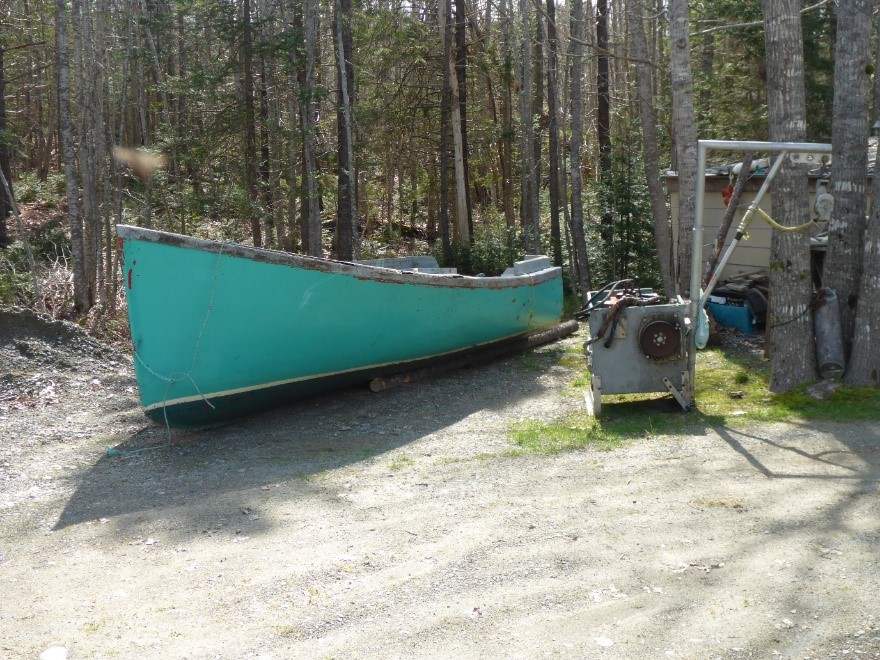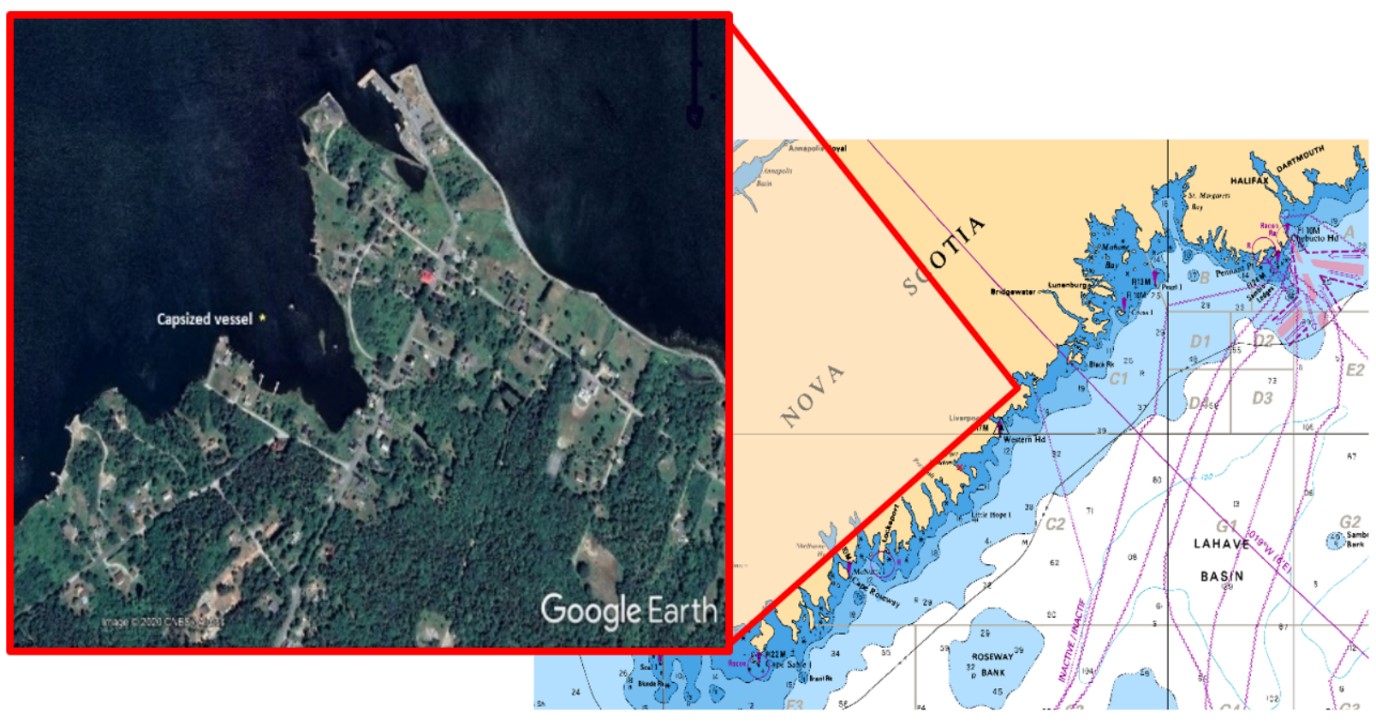Capsizing and loss of life
Unnamed fishing vessel
Medway Harbour, Nova Scotia
The Transportation Safety Board of Canada (TSB) investigated this occurrence for the purpose of advancing transportation safety. It is not the function of the Board to assign fault or determine civil or criminal liability. This report is not created for use in the context of legal, disciplinary or other proceedings. See Ownership and use of content. Masculine pronouns and position titles may be used to signify all genders to comply with the Canadian Transportation Accident Investigation and Safety Board Act (S.C. 1989, c. 3).
Description of the vessel
The occurrence vessel, which was unnamed, was a 5.79 m fishing vessel of open construction and made of fibreglass (Figure 1). The vessel was powered by a 25 hp, 4 stroke outboard motor, and was equipped with a trap hauler driven by a gasoline engine and had an on-board battery-powered electronic fish finder.
History of the voyage
On 05 May 2018, at about 0815,Footnote 1 the fishing vessel departed a private wharf in Port Medway, Nova Scotia, with 2 people on board. The wind was from the southwest at 35 knots, with 1 m seas, and the water temperature was about 11 °C.
The master and crew member ventured to an area within 2 nautical miles (NM) off the wharf to haul crab traps. The area that they planned to fish was within Medway Harbour and somewhat sheltered, although there were whitecaps on the water.
Shortly after 1000, the Royal Canadian Mounted Police (RCMP) received a call that a small fishing vessel had overturned 0.04 NM northeast of Beach Cove, Port Medway, Nova Scotia (Figure 2). Locals knew this area was near where the master of the fishing vessel stored his crab crates, leading them to believe it was his vessel. The RCMP called the Joint Rescue Coordination Centre Halifax and a search was launched. The search involved the RCMP, a fast rescue craft from the Liverpool fire department, a Department of Fisheries and Oceans fast rescue craft, a local fishing vessel, a Joint Rescue Coordination Centre helicopter, a fixed-wing aircraft from 14 Wing Greenwood, Nova Scotia, and a local shore-based search and rescue crew that included members of the community.
At around 1045, the crew member was found on the shoreline approximately 0.08 NM east of the overturned vessel. The crew member was unresponsive and was transported to hospital by ambulance, where she was later pronounced dead. The crew member was not wearing a lifejacket or a personal flotation device (PFD).
At around 1135, a member of the local community embarked on a fire department fast rescue craft to help locate the master’s crab crates, with the intention of hauling the crates up to see if the master was entangled in them. At 1250, the community member saw a submerged line. As the line was hauled up, the master’s body was found entangled in the line. The community member helped fire department personnel recover the body. The master was not wearing a lifejacket or a PFD.
The fishing vessel was recovered, towed to shore, and righted by the crew from the Department of Fisheries and Oceans fast rescue craft.
Personal flotation devices
Not wearing a PFD on a fishing vessel is an unsafe practice that has been identified by the TSB over the past 20 years. PFDs are designed to be worn at all times, permitting individuals to work without the restrictions of a lifejacket. However, many fish harvesters are resistant to wearing them, citing issues such as discomfort, the risk of entanglement, and the perception that it is not practical or normal to use them. Furthermore, it has been determined that fish harvesters often underestimate the risk of falling overboard.Footnote 2
Following the investigation into the 05 September 2015 capsizing of the fishing vessel Caledonian,Footnote 3 the TSB recommended that
the Department of Transport require persons to wear suitable personal flotation devices at all times when on the deck of a commercial fishing vessel or when on board a commercial fishing vessel without a deck or deck structure and that the Department of Transport ensure programs are developed to confirm compliance.
TSB Recommendation M16-05
As of 13 July 2017, Transport Canada’s Fishing Vessel Safety Regulations revised the requirements for the carriage of lifejackets and PFDs on fishing vessels. If an open-deck fishing vessel embarking on a Class 2 Near Coastal voyage, such as the occurrence vessel, does not carry lifejackets, all persons on board must wear a PFD at all times.Footnote 4
Risk-based regulations and industry initiatives have been developed to change behaviours and create awareness about the importance of wearing PFDs. PFD manufacturers have also improved PFD design to address fish harvester concerns about comfort and constant wear. Yet many fish harvesters continue to work on deck without wearing a PFD, even when one is available.
In this occurrence, neither crew member was wearing a lifejacket or PFD, nor were any found during the search efforts.
Emergency position-indicating radio beacons
An emergency position-indicating radio beacon (EPIRB) transmits an emergency signal, either automatically or when activated by the crew, to immediately alert search and rescue (SAR) resources and initiate rescue efforts.
The Fishing Vessel Safety Regulations require a vessel of any length operating in sheltered waters or within 2 NM of shore, such as the fishing vessel involved in this occurrence, to carry the following on board:
- one or more life rafts or recovery boats with a total capacity that is sufficient to carry the number of the persons on board; or
- the following equipment:
- an EPIRB or a means of two-way radio communication, unless the vessel is carrying on board an EPIRB required by the Ship Station (Radio) Regulations, 1999, and
- if the water temperature is less than 15°C, an immersion suit or an anti-exposure work suit of an appropriate size for each person on board.Footnote 5
Under these regulations, such vessels are required to carry some combination of the equipment listed above, which may not necessarily include an EPIRB.
The occurrence vessel did not have an EPIRB or a very high frequency radiotelephone on board, and it was not required by regulation to carry these devices. The 2 crew members each carried a cellphone on their person, which met regulatory requirements.
Previous TSB investigationsFootnote 6 have found that carrying an EPIRB can contribute to saving crew members’ lives. When a vessel’s EPIRB is activated, it automatically transmits a continuous distress signal, indicating the vessel’s precise location; with this information being available to other vessels or SAR resources, they can arrive on scene more quickly, greatly reducing the amount of time people are in the water before help arrives.
Between February 2010 and May 2018, the TSB received reports of 10 occurrences (resulting in a total of 19 fatalities) involving the capsizing or sinking of small fishing vessels less than 12 m in length that were not equipped with an EPIRB. No distress signal was received by other vessels or SAR resources in any of these occurrences.
The TSB has recommended previously that small fishing vessels carry an EPIRB or other appropriate equipment that floats free, automatically activates, alerts the SAR system, and provides position updates and homing-in capabilities.Footnote 7
Related occurrences
M18A0078 (Ocean Star II) – On 12 May 2018, the 8.69 m fishing vessel Ocean Star II, with 3 crew members on board, capsized while hauling lobster traps approximately 0.05 NM (100 m) from the shoreline at Colindale, Nova Scotia. Although all 3 crew members survived the initial capsizing, only 1 crew member survived after being in the water and making his way to shore. In this particular occurrence, none of the crew was wearing a PFD or any other type of lifesaving equipment. In addition, the vessel was not equipped with an EPIRB.
M18A0303 (Kyla Anne) – On 18 September 2018, the 11.5 m fishing vessel Kyla Anne, with 3 crew members on board, capsized while returning to port after a lobster fishing trip about 1 NM north of North Cape, PEI. Only 1 crew member survived the capsizing. No PFDs or an EPIRB were on board at the time of the occurrence.
Safety messages
The TSB continues to see PFDs not being worn by crews in fatal fishing vessel occurrences such as this one. It is important that fish harvesters take responsibility for their own safety and the safety of their crews by ensuring that PFDs are worn when working on board their vessels. Wearing a PFD can minimize the adverse consequences of being immersed in water and increase a person’s chances of survival until help arrives.
Being prepared for emergencies is paramount to fishing vessel safety. In an emergency, an important factor for survival is having the ability to request assistance quickly. A distress-alerting device, such as an EPIRB, can automatically broadcast a signal that the vessel is in distress and provide a precise location for search and rescue. It is important that vessels have reliable means of distress alerting so that an emergency response can be initiated as soon as possible, increasing the chances of survival for the vessel occupants.
Although carrying a cellphone on board can meet the requirement for a means of 2-way communication, operators should be aware of the limitations of such devices in emergency situations.
This report concludes the Transportation Safety Board of Canada’s investigation into this occurrence. The Board authorized the release of this report on . It was officially released on .

